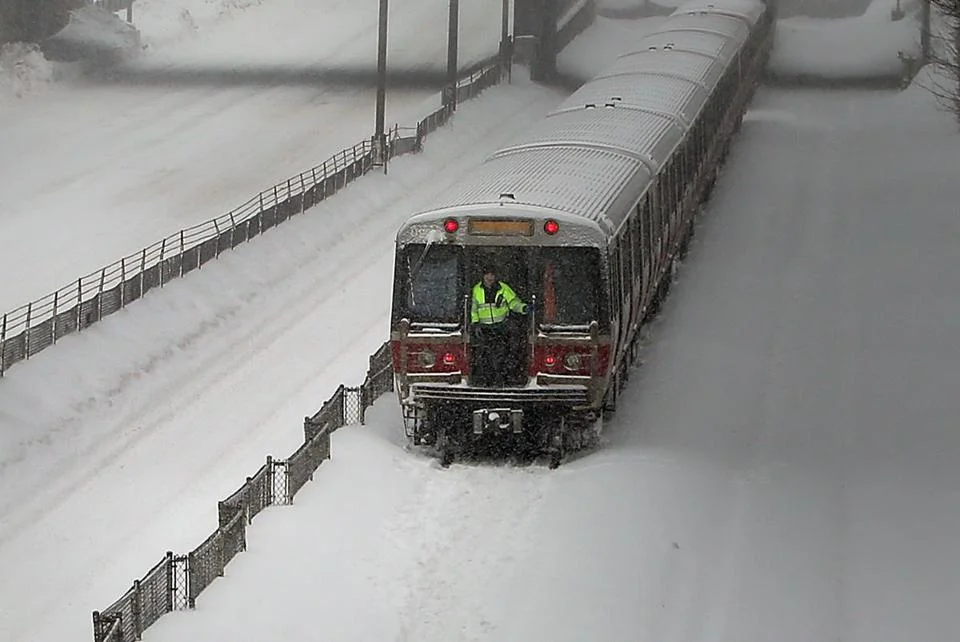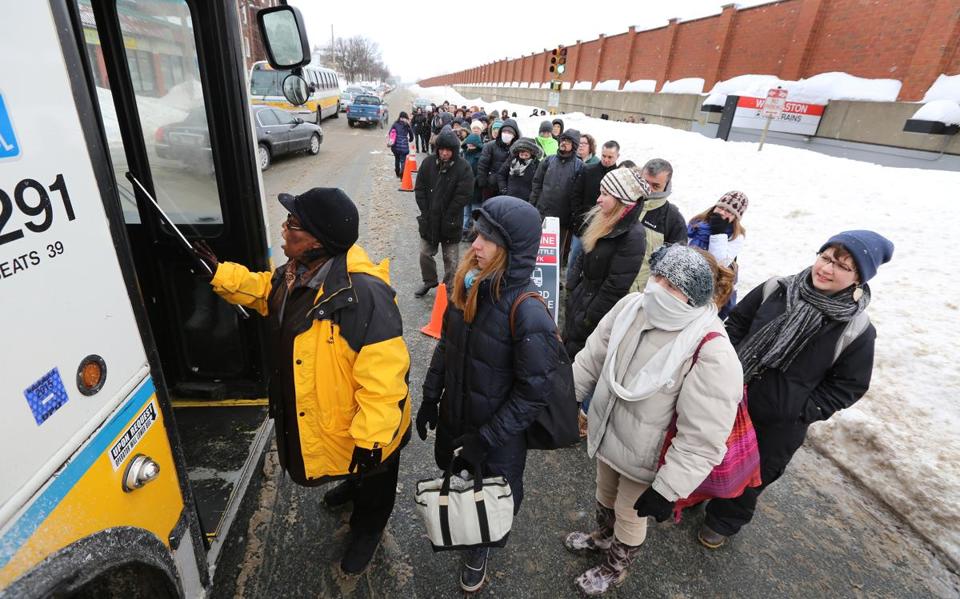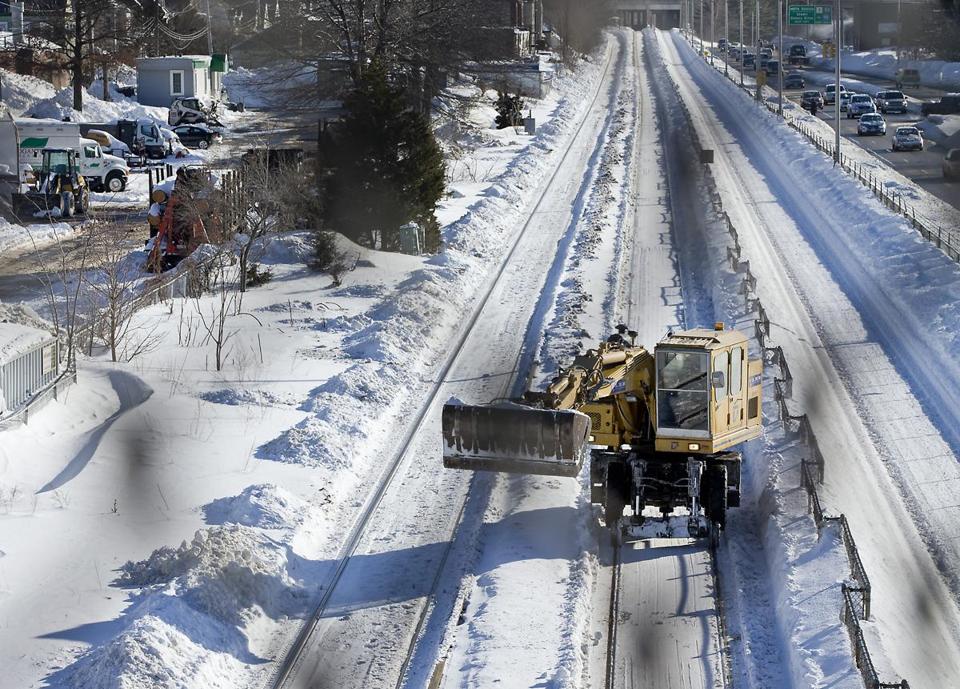
UPDATE: NYC Donates Snow Fighting Equipment; Governor Releases $30 Billion Plan
Spring has sprung today for transit as NYC MTA CEO Thomas Prendergast announced a small donation of snow fighting equipment and the Governor announced a commitment of $30 billion over 15 years to drastically upgrade the MBTA's infrastructure and equipment.
APRIL FOOL'S DAY SATIRE UPDATE: Sadly, we won't be getting a donation of snow fighting equipment and the Governor seems to be committed to be more interested in leaning on gains to be had from operational efficiency rather than a combined invest-and-reform approach.
Spring has sprung today for transit as NYC MTA CEO Thomas Prendergast announced a small donation of snow fighting equipment and the Governor announced a commitment of $30 billion over 15 years to drastically upgrade the MBTA's infrastructure and equipment.
NYC's de-icer car, a retrofitted subway car from a series that has long since been retired, is just narrow and short enough to run on all MBTA heavy rail lines - Red, Blue, and Orange - to clear ice from the third rail.
'You'll need a diesel locomotive to be able to push the de-icer car, but...uhhh...my information is that you don't have one so we'll throw one in, too', said Prendergast to standing MBTA GM DePaola at South Station.
'I was very surprised', said DePaola. 'I woke up to consecutive calls from [Transportation Secretary] Stephanie Pollack and my secretary that I needed to make my way as fast as I could to South Station. They had just gotten word from the MTA that Prendergast had just left Penn Station on an Amtrak train with a special delivery.'
Landmark Capital Investment in Transit
Meanwhile at home in the Bay State, Governor Baker, Senate President Rosenberg, and House Speaker DeLeo jointly announced their 15-year, $30 billion plan to drastically increase investment in the T.
'We are fully committed to investment levels commensurate with the maintenance needs of the country's 4th largest transit system', said Baker. The plan was sparked by widespread outcry by Massachusetts residents for better transit and inspired by a recent crowd-funding effort to raise $30 billion for capital investment in the T. 'We ended up raising the money by getting donations from all the legislators at the State House and going door-to-door raising money with various businesses in our towns.'
The plan includes a veritable wish list of regional access and core upgrade projects:
- Commuter Rail Electrification
- North-South Rail Link
- Urban Ring - Silver Line to be fully upgraded to light rail
- Outer Urban Ring on Route 128
- 'Overground' network - frequent service on inner-core commuter rail segments, defined by the DMU plan released by MassDOT
- Green and Blue Line signal modernisation
- Power systems overhaul for all rapid transit lines
- 6 BRT routes
- Blue Line Extension to Lynn
- Red-Blue Connector
- Pay-off of all existing capital construction debt
Completion for most projects is slated to be within the next 10 years. The plan is to have frequencies of rush hour trains to be every 30 minutes on commuter rail, 10 minutes on 'Overground' services, 3 minutes on all rapid transit lines, and less than 2 minutes on light rail. The MBTA and MassDOT are also accelerating work with the transport departments of Boston, Cambridge, Somerville, Everett, Malden, Medford, Arlington, Watertown, Waltham, and Brookline to establish dedicated bus lanes or other infrastructure to improve bus travel times and ensure buses can establish frequencies to arrive every 5 mins during rush hour.
Paying off the T's debt will also eliminate over $400 million annual operating budget commitments and will allow the T to return to pre-austerity staffing levels.
'We'll now have the proper operating budget to give the people of the Boston metro the service they've expected of us for decades and that we have never had the investment to deliver on', said MBTA GM DePaola. 'This should brighten the day of many of our back office management, many of whom have been burdened with the work of three or more people for years as we've had to cut our budget by simply not back-filling positions as people left or retired.'
In addition to the budgetary breathing room, MassDOT has announced its partnership with several international development and property management companies to engage in accelerated development of multiple commuter rail lots and MBTA properties into mixed income housing, offices, and retail.
'Once and for all, we want to stop this practice of selling property for a one time cash infusion to make ends meet', said Secretary Pollack. 'We will be working with these neighbourhoods to add much-needed housing and valuable retail and office spaces to enrich the spaces around stations. We are capitalising on our vast properties to return even more revenue to reinvest in the system after we've caught up to the massive backlog of projects from decades of underinvestment.'
Regarding conservative concerns about excessive investment in the MBTA, the governor cited his understanding that operational efficiency can happen as we invest in the system. 'As my good friend Somerville Mayor Joe Curtatone once said, "We can walk while we chew gum." I have confidence in the management I have in place at MassDOT and the T; we need to give these people the right resources to succeed.'
An Emergency Transportation Plan to Fix Boston's Transit Crisis
Yesterday we learned that due to decades of neglect the MBTA will need at least 30 days to restore service to the normal level of delays, signal problems and disabled trains we're used to. While there is plenty of blame to go around, right now we must focus on the current emergency.
Yesterday we learned that due to decades of neglect the MBTA will need at least 30 days to restore service to the normal level of delays, signal problems and disabled trains we're used to. While there is plenty of blame to go around, right now we must focus on the current emergency.




We must act quickly to implement a temporary transit network that would people to resume their lives before the state's economy collapses and half the city's population is out of work. Mayor Walsh and MBTA General Manager Beverly Scott should seek help from cities and transit agencies who have experience with natural disasters. With bold political leadership and around 1,000 buses from across the northeast we can put an emergency transportation plan into action.
For guidance we should look to MTA New York City Transit, which in 2012 implemented emergency "bus bridges" connecting Brooklyn and Manhattan two days after Hurricane Sandy knocked out all subway service in the city's core (photos). The city used simple cones to create dedicated bus lanes along the shuttle route and police officers to enforce the lanes and keep over 200 buses moving on each route. MTA also ran a long-term shuttle route to replace the A line in Queens and a year earlier replaced suspended commuter rail service after Hurricane Irene.
Here and now, a network of emergency shuttle bus routes must be created based roughly on known travel patterns. Bus routes would not exactly mimic subway corridors but they would get you into the city's core where you can walk or use what's left of the T. Some routes would use dedicated bus lanes and receive priority over all other traffic, with police enforcement, while other corridors would be open only to buses. For all of the issues with bus service, the MBTA does a great job running shuttle bus links such as Harvard-Alewife and Lechmere-North Station when things are planned in advance.
Cars carrying fewer than 3 occupants would be prohibited from entering the city or using major highways inside Route 128. Slug lanes would allow those who must drive from suburban areas to pickup additional passengers before continuing on. Large parking lots along I-495 and Route 128 can be turned into park-and-ride lots with bus shuttles operating in dedicated bus lanes on all major highways.
Bikes must be part of the solution. It is certainly cold outside but desperate times call for desperate measures. Better to ride 3 miles in the cold than wait for a bus in the cold for the same 15 minutes, and every 50 bikes represents one more bus available elsewhere. Designating corridors like Washington St, Massachusetts Ave, Huntington St and Commonwealth Ave for buses and bicycles only would enable reasonably fast limited-stop bus service while giving people people a safe place to ride. Secure bicycle parking tents can be setup in several downtown locations and an emergency ordinance could require most office buildings to allow bikes inside until full subway service resumes.
Walking should be encouraged whenever possible in order to minimize stress on the transit system. Bostonians have not experienced a transit strike in recent decades but experience from other cities shows people will gladly walk a few miles if they can. Currently our sidewalks are a treacherous mix of snow and ice, so vehicle lanes can be converted to pedestrian lanes until sidewalks are clear, with some key roads open to buses and pedestrians only.
Some of these measures may sound extreme, but desperate times call for desperate measures, and I believe even the harshest critics of transit would be surprised by how well the city would function if they would just allow a demonstration.
At the very least, this plan would prevent the total collapse of the region and it is our chance to show definitively that a fast, frequent and comprehensive transit network is invaluable to the entire region. Eventually we'll wonder how we ever lived without one.
MBTA ROC Proposes Solution to Student Auto-Dependence and Late Night Service Costs
The MBTA Rider Oversight Committee released a report yesterday on the viability of using funds from a proposed student pass program with the region's innumerable universities to fund late night service. This follows months of research into other systems that have university transit pass programs in place and how those programs have succeeded phenomenally.
The MBTA ROC's proposed program would follow in the footsteps of the Chicago Transit Authority's (CTA) U-Pass program, where area colleges are given the opportunity to purchase unlimited-use transit passes for no less than 100% of their full-time student body. In exchange for a 100% buy-in, the MBTA would offer semester passes to participating Boston-area colleges at a mark-down greater than the current college student discount. The program would be mutually beneficial since the students would be granted free access to all MBTA subways, light-rail vehicles, and buses, while the MBTA would receive additional revenue from the increased pass sales (the CTA, for example, generated $25 million in revenue through their U-pass program last year). Furthermore, the MBTA would be required to use that additional revenue to provide overnight service, which would be a benefit to all MBTA riders.
The biggest and nearly insurmountable hurdle will be convincing these universities that paying into the program will be buying students real mobility. The Green Line and 57/A buses along the BU and BC corridors are hardly the paragon of transit reliability and speed.
Additionally, there are many private carriers either run by the universities or contracted on their behalf that already provide a level of mobility across campus. These services could instead be given to the MBTA as an extension of the relationship with the T, but that is not explored in the report and would likely be a venture very far down the road.
The $10 million would only go to operations of extended late night bus service since the T still needs to shut down rail service for maintenance, as has been covered by numerous press outlets, including the Metro and the impressive documentary that leads this post.
Even more damning is the logistics in incorporating multiple technologies and standards into the same RFID card. Chicago's new Ventra system uses pre-paid debit cards integrated into MasterCard's PayPass system, which will eventually evolve into MasterPass and is already compatible with a number of RFID smartphones. HID, which provides the contactless card systems used by most colleges for integrated student ID key cards for residence halls, is also working toward integration with smartphones, which leads us even further toward the possibility that phones will be the common denominator for contactless payment and security systems.
Phones are already a conveyance for currency in Africa and have been for years. For those without NFC/RFID-enabled phones, systems like Ventra still enable fare cards that work with the contactless system. Many transit agemcies are looking to replace their expensive and proprietary fare payment systems, including the MBTA. GM Scott has already voiced her interest in replacing the CharlieCard system and New York City has been working with numerous agencies to find consensus before they replace their nearly 20-year-old MetroCard system.
CharlieCard, less than 10 years old, was delayed, well over budget, and outdated by the time it was fully implemented. The MBTA's reaction to the MIT hack of the CharlieCard itself was a significant setback and current policy and tightness around the system is preventing its growth, as acknowledged by many within the T. Standardisation of the payment system is the only way forward and that may well mean our phones are the lowest common denominator.
Categories
- Children (1)
- Diversions (1)
- Olympics (1)
- MAPC (2)
- Red–Blue Connector (2)
- Urban Design (3)
- Bus (4)
- Fares (4)
- Late Night Service (4)
- MBTA ROC (4)
- Silver Line (4)
- Snow (5)
- Blue Line (8)
- Emergency (8)
- Orange Line (8)
- Public Comment (8)
- Maintenance (9)
- Operations (9)
- Signage (9)
- Fare Collection (10)
- Labs (11)
- Safety (11)
- Planning (12)
- Communication (14)
- MBCR (14)
- MassDOT (14)
- Green Line (16)
- History & Culture (16)
- Red Line (18)
- MBTA Bus (21)
- Commuter Rail (24)
- Advocacy (26)
- Capital Construction (28)
- Politics (30)
- Podcast (35)
- News (38)
- Media (40)
- Funding (42)
- Statements (50)
- MBTA (57)


![o-THOMAS-PRENDERGAST-facebook[1].jpg](https://images.squarespace-cdn.com/content/v1/533b9a24e4b01d79d0ae4376/1427896903242-YCFS2186O8FQP1WMQGTV/o-THOMAS-PRENDERGAST-facebook%5B1%5D.jpg)

